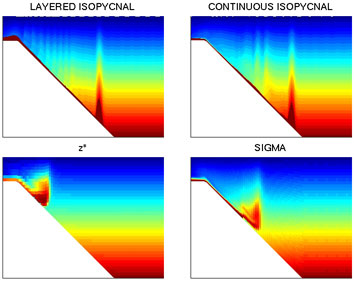Ocean Circulation Models
While ocean models start with the same continuous equations, the discrete equations possess important distinctions that play a role in the simulation features. In particular, different parts of the ocean are most naturally represented using different vertical coordinate systems. Level-coordinate models consider each box at the same level, with geopotential or pressure the common basis for defining levels. These models are relatively easy to code and have been the basis for ocean climate modeling since the 1960s. Such models may also have particular advantages in representing the transition between the poorly stratified mixed layer and the interior ocean where flow is predominantly along density surfaces. In contrast, isopycnal models handle the interior ocean more naturally, and may also have significant advantages in representing thin dense overflows. In shallow shelf regions, where the top and bottom boundary layers are thought to be most important, many oceanographers use terrain-following coordinate systems. For more discussion on matters of vertical coordinates and their use in the modeling community, see the review paper from Griffies et al.
Ocean Model Development at GFDL
In 2005, GFDL embarked on two parallel and complementary paths in ocean climate modeling. The first focused the numerical and physical enhancement of our workhorse ocean model, the Modular Ocean Model (MOM). The second effort prototyped a new generation of ocean model for the study of climate, whose Lagrangian vertical coordinate is based on density layers rather than depth or pressure levels used in MOM. This second effort produced the Generalized Ocean Layer Dynamics (GOLD) code. Being able to simulate the ocean climate system using two distinct and complementary ocean model classes is an exceptionally valuable capability, as exemplified in studies using GFDL’s ESM2M (level based using MOM) and ESM2G (isopycnal based using GOLD) Earth System Models. It provides us with important tools to establish robust features of the climate simulations, such as the response of the Atlantic Meridional Overturning Circulation in a warming planet.
MOM configurations and releases

The Modular Ocean Model (MOM) is the canonical large-scale ocean climate model used at GFDL and around the world. MOM4 formed the basis of the CM2.1, CM2M, ESM2M, and CM2.5 climate models used for high-end modeling that contributed to the IPCC AR4 and AR5 assessments. MOM5 is the most recent version released in October 2012 (http://mom-ocean.org). The model’s origins date back to the community code first developed by Kirk Bryan and Mike Cox in the 1960's-1980's, to which many other ocean climate models can trace their origins.
GOLD configurations and release
The Generalized Ocean Layer Dynamics (GOLD) is a generalized Lagrangian-coordinate ocean code (Adcroft and Hallberg, 2006). GOLD can be configured using geopotential (z*), terrain-following (σ), layered isopycnal, or a continuous isopycnal (ρ) coordinate for describing the vertical (see, e.g., White et al., 2009 and the animation at right). Nonetheless, the principle use of GOLD has been as an isopycnal coordinate ocean climate model, following in the lineage of the Hallberg Isopycnal Model (HIM). GOLD was released for the first time in September 2012.
Next Generation Ocean Model
The MOM and GOLD development paths were largely complementary, though they fed off one another during the intense development period from 2005-2012. These two paths have now reached their successful conclusion with the climate simulations of GFDL’s two new Earth System Models, ESM2M and ESM2G, and the public release of MOM5 (http://mom-ocean.org) and GOLD (http://code.google.com/p/gold-omod/). As of late 2012, GFDL has embarked upon an effort to merge the best capabilities of these two codes into MOM6.
While MOM5 and GOLD are distinct developments and fundamentally differ in formulation, MOM6 will blend these two disparate approaches. MOM6 will incorporate the vertical coordinate work incorporated into GOLD, including the conservative representation of wetting and drying essential for evolving ice shelf grounding lines, along with key physical parameterizations and analysis features of MOM5. MOM6 will be the ocean code used in the next GFDL coupled climate model. Additionally, MOM6 will become part of the long-standing MOM community of codes, with thorough documentation and test cases.


